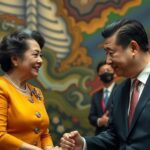Politics
AFRICA, ANGELES, ASIA, BELT AND ROAD INITIATIVE, BRAZIL, BRI, CHINA, GENERAL SECRETARIAT OF THE PRESIDENCY OF BRAZIL, GEOPOLITICS, GLOBAL TIMES, INFRASTRUCTURE PROJECTS, LATIN AMERICA, LIMA, MACEDO, MARC, MÁRCIO MACÊDO, MERCADO LOBATON, MEXICO, NORTH AMERICA, PACIFIC OCEAN, PERCY PENA ANGELES, PERU, RIO DE JANEIRO, SECRETARIAT, SOUTH AMERICA, TRADE, TRADE RELATIONS, UNITED STATES
Clara Montgomery
Belt and Road Initiative Expands Influence in Latin America: Key Developments from Peru to Brazil
The Belt and Road Initiative (BRI) is gaining traction in Latin America, particularly in Peru and Brazil, despite limited public awareness. Recent developments, including the inauguration of Chancay Port and strategic discussions between Chinese and Latin American leaders, highlight the increasing importance of economic cooperation. The BRI is anticipated to foster significant trade and investment opportunities, underscoring China’s role as a key economic partner for the region.
In recent years, the Belt and Road Initiative (BRI) has begun to establish a significant presence in Latin America, yet awareness of this program remains limited in countries like Peru and Brazil. During conversations with residents in Lima and Rio de Janeiro, many expressed unfamiliarity with the specifics of the BRI, although there was notable enthusiasm for economic cooperation with China. Individuals shared insights into the advantages of exporting agricultural goods to Chinese markets, emphasizing the benefits of trade over local sales.
The BRI has recently achieved pivotal milestones through the inauguration of Chancay Port in Peru—a key project expected to enhance trade routes between Asia and Latin America. This project, combined with Brazil’s growing interest in aligning its development strategies with BRI objectives, signifies a deeper integration of Chinese investment in the region. With 22 out of 26 Latin American countries already engaging in BRI initiatives, the program is manifestly gaining traction and establishing vital connections.
At high-profile meetings, including discussions between Chinese officials and various Latin American leaders, the BRI has been extolled for its potential to foster economic growth and job creation, particularly amid ongoing global uncertainties. China is perceived as a stable ally, providing enticing economic opportunities, which positions the BRI to gain further momentum across this diverse region.
The Belt and Road Initiative (BRI), launched by China, aims to enhance global trade and infrastructure development across various regions, including Asia, Africa, and Latin America. In recent years, it has begun to permeate Latin America, evidenced by growing interest from several countries. While major infrastructure projects have commenced, public awareness and understanding of the BRI’s specifics remain notably sparse, particularly in nations such as Peru and Brazil. The BRI’s emphasis on partnership, economic cooperation, and development aligns with Latin America’s quest for enhanced economic ties, particularly with China, which has substantially increased its investments in the region.
The engagement of Latin America with the Belt and Road Initiative signifies a transformative shift in economic cooperation between China and the region. With established projects like Chancay Port and burgeoning synergies in Brazil, the BRI is set to enhance trade links and catalyze economic growth. As countries continue to recognize the potential benefits of participating in the BRI, it is poised to become a framework for broader and deeper financial integration among Latin American economies.
Original Source: www.globaltimes.cn








Post Comment